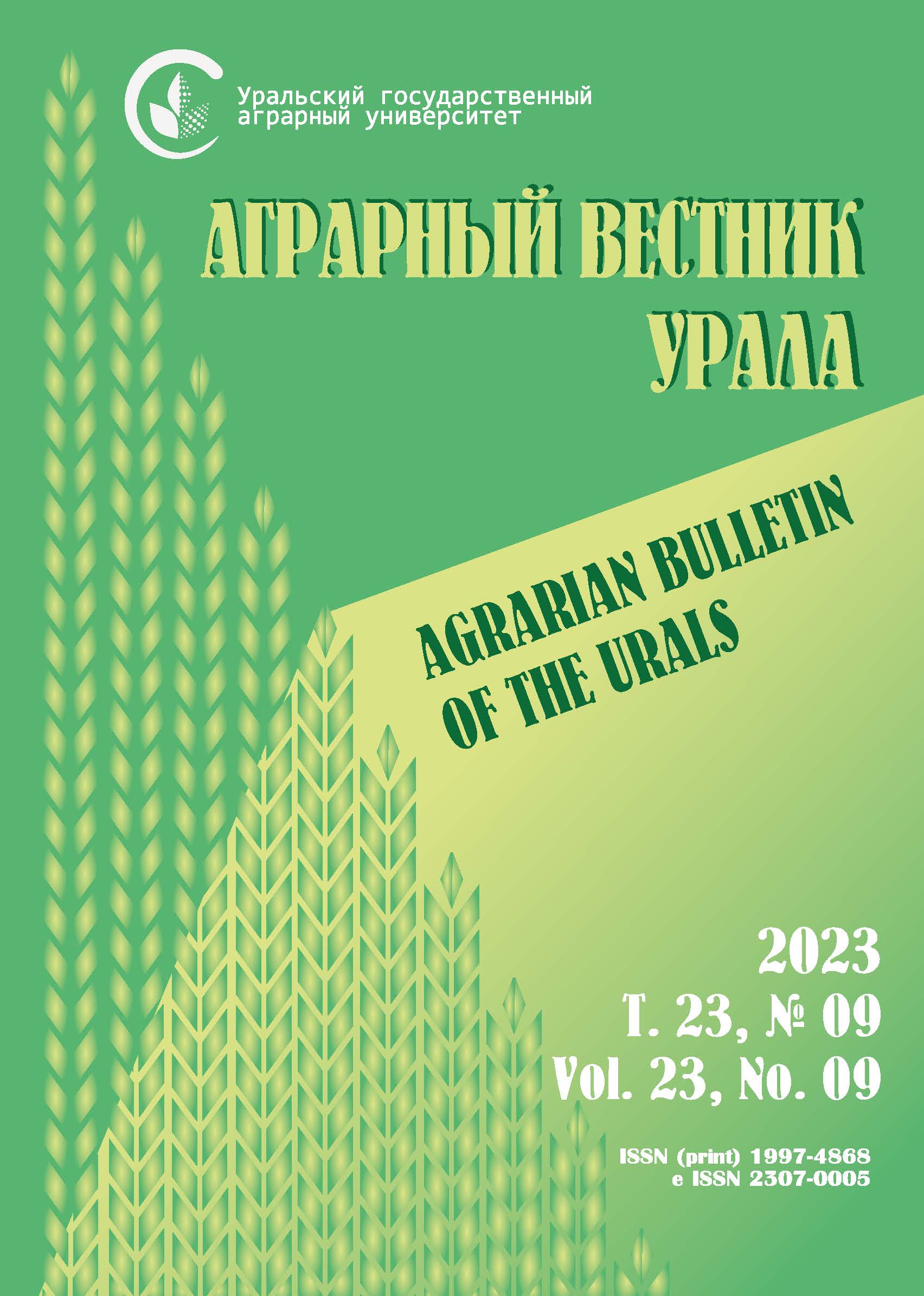from 01.01.1991 until now
Ekaterinburg, Ekaterinburg, Russian Federation
Ekaterinburg, Ekaterinburg, Russian Federation
Ufa, Russian Federation
Ufa, Russian Federation
Abstract. The aim of the study is to carry out a comprehensive assessment of the food supply of the population of the federal subject (on the example of Bashkortostan) in the context of external and internal systemic challenges and restrictions. The article updates that the observed conditions for the development of the agro-food system at the national level and at the level of federal subjects are accompanied by unprecedented changes that are directly related to the emergence of new challenges, trends and threats, the active introduction of innovative and digital technologies in food of animal origin. The conceptual and theoretical and methodological basis of the study was the fundamental provisions of modern theories of the development of the agro-food market and food supply for the population, human capital, economic growth and sustainable functioning of rural territorial entities. Methods. As a means of instrumental and methodological apparatus of research, a systematic approach was used in combination with the following methods: monographic, abstraction, graphic visualization, generalization and systematization, comparative analysis. A comprehensive study of food supply for rural and urban residents of the Republic of Bashkortostan is based on the results of a content analysis of current trends, problems and strategic prospects for the development of agriculture and the agro-food market in the region. Results. In this study, a comprehensive assessment of the provision of the population of the Republic of Bashkortostan with food of animal origin (meat and meat products, milk and dairy products) was carried out. The key problems hindering the development of the livestock and poultry complex of the republic are identified. The dynamics of indicators reflecting the number of livestock, the productivity of livestock and poultry in the agro-formations of the region is considered. An assessment of individual social indicators of the functioning of rural territorial entities at the regional level is given. A detailed analysis of the balance of resources (production, imports and exports) of meat and meat products, milk and dairy products, formed on a republican scale, was carried out. Practical proposals have been developed aimed at improving the criteria and parameters of self-sufficiency of the population of the federal subjects of our country with certain types of agro-food products. The scientific novelty lies in the substantiation of new provisions aimed at the effective assessment of the food supply of the population of the federal subject with food of animal origin in the face of modern challenges, threats and restrictions.
food security, food supply, food products, agro-food market, agro-formations
1. Rahbari M., Khamseh A.A., Mohammadi M. Robust optimization and strategic analysis for agri-food supply chain under pandemic crisis: Case study from an emerging economy // Expert Systems with Applications. 2023. Vol. 225. Article number 120081. DOI:https://doi.org/10.1016/j.eswa.2023.120081. EDN: https://elibrary.ru/VMCDGL
2. O’Connell S., Boles J., McClellan R., Demers D. Mapping food security in Arkansas // Applied Geography. 2023. Vol. 158. Article number 103020. DOI:https://doi.org/10.1016/j.apgeog.2023.103020. EDN: https://elibrary.ru/GXNXHQ
3. Li Y., Filimonau V., Wang L., Cheng S. Inter- and intra-annual changes in food consumption among rural households in East China // Journal of Rural Studies. 2022. Vol. 95. Pp. 109-124. DOI:https://doi.org/10.1016/j.jrurstud.2022.07.022.
4. Rohr V., Blakley J., Loring P. A framework to assess food security in regional strategic environmental assessment // Environmental Impact Assessment Review. 2021. Vol. 91. Article number 106674. DOI:https://doi.org/10.1016/j.eiar.2021.106674. EDN: https://elibrary.ru/CXGIMO
5. Tantiwatthanaphanich T., Shao X., Huang L., Yoshida Y., Long Y. Evaluating carbon footprint embodied in Japanese food consumption based on global supply chain // Structural Change and Economic Dynamics. 2022. Vol. 63. Pp. 56-65. DOI:https://doi.org/10.1016/j.strueco.2022.09.001. EDN: https://elibrary.ru/IJMCFY
6. Enthoven L., Skambracks M., Broeck G.V. Improving the design of local short food supply chains: Farmers’ views in Wallonia, Belgium // Journal of Rural Studies. 2023. Vol. 97. Pp. 573-582. DOI:https://doi.org/10.1016/j.jrurstud.2023.01.016. EDN: https://elibrary.ru/YDPPAA
7. Stovba E. V., Stovba A. V. Scenario modeling of the development of agricultural production at the level of rural territory of the region // International Scientific Conference «Far East Con» (ISCFEC 2019): Advances in Economics, Business and Management Research. 2019. Vol. 79. Pp. 225-227. DOIhttps://doi.org/10.2991/iscfec-19.2019.62. EDN: https://elibrary.ru/ENFDKJ
8. Haync D. A., Galiev R. R. Prodovol'stvennoe samoobespechenie Rossii: aspekty poleznosti i izderzhek // Problemy prognozirovaniya. 2021. № 5 (188). S. 162-172. DOI:https://doi.org/10.47711/0868-6351-188-162-172. EDN: https://elibrary.ru/NFETEE
9. Semin A. N. K voprosu o perspektivah razvitiya otechestvennogo sel'skogo hozyaystva // ETAP: ekonomicheskaya teoriya, analiz, praktika. 2022. № 3. S. 64-72. DOI:https://doi.org/10.24412/2071-6435-2022-3-64-72. EDN: https://elibrary.ru/KCNDEQ
10. Buhtiyarova T. I., Mihaylyuk O. N., Baturina I. N. Bazovye usloviya prodovol'stvennoy bezopasnosti gosudarstva // Ekonomika sel'skohozyaystvennyh i pererabatyvayuschih predpriyatiy. 2022. № 11. S. 2-5. DOI:https://doi.org/10.31442/0235-2494-2022-0-11-2-5. EDN: https://elibrary.ru/FYHAUZ
11. Racional'nye normy potrebleniya pischevyh produktov [Elektronnyy resurs] // Oficial'nyy sayt Minzdrava Rossii. URL: https://minzdrav.gov.ru/opendata/7707778246-normpotrebproduct/visual (data obrascheniya: 21.03.2023).
12. Gusmanov R. U., Stovba E. V., Avarskii N. D., Lukyanova M. T., Galiev R. R. Foresight as an innovative tool for strategic planning of sustainable rural development // Progress in Industrial Ecology. 2020. Vol. 14. No. 3-4. Pp. 284-305. DOI:https://doi.org/10.1504/PIE.2020.113432. EDN: https://elibrary.ru/JHJAJZ
13. Askarov A. A., Stovba E. V., Askarova A. A. Ecological and economic evaluation of using arable land in the Republic of Bashkortostan // IOP Conference Series: Earth and Environmental Science. 2019. Vol. 274. Article number 012095. DOI:https://doi.org/10.1088/1755-1315/274/1/012095. EDN: https://elibrary.ru/JEXCBC
14. Galiev R. R., Arens H. D. Determinanty prodovol'stvennogo samoobespecheniya Rossii i dostupnost' produktov pitaniya // Problemy prognozirovaniya. 2021. № 3 (186). S. 41-53. DOI:https://doi.org/10.47711/0868-6351-186-41-53. EDN: https://elibrary.ru/GMEPEZ
15. Sel'skoe hozyaystvo Respubliki Bashkortostan: statisticheskiy sbornik. Ufa: Bashkortostanstat, 2022. 177 s.
16. Gusmanov R., Askarov A., Lukyanova M., Kovshov V., Stovba E. Strategic planning of rural development based on foresight methodologies // Scientifica. 2020. Vol. 2020. Article number 5195104. DOI:https://doi.org/10.1155/2020/5195104. EDN: https://elibrary.ru/GMQZZY
17. Arens H. D., Galiev R. R. Zhiznesposobnost' fermerskih domohozyaystv v Rossii: teoreticheskie podhody i prakticheskie vyvody // Problemy prognozirovaniya. 2019. № 3 (174). S. 65-79. EDN: https://elibrary.ru/FBGZCT
18. Sharapova N. V., Sharapova V. M., Sharapov Yu. V. Gospodderzhka sel'hoztovaroproizvoditeley i ee rol' v razvitii molochnogo skotovodstva // APK: ekonomika, upravlenie. 2022. № 11. S. 74-80. DOI:https://doi.org/10.33305/2211-74. EDN: https://elibrary.ru/CGTENS









